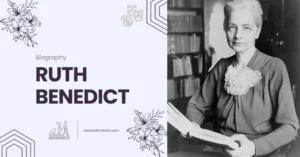AI Answer Evaluation Platform Live Now. Try Free Answer Evaluation Now
W. H. Rivers
William Halse Rivers or W.H Rivers was not your typical anthropologist. A trained physician and psychologist, he brought a clinical eye and experimental rigor to a young discipline still finding its footing. Best known for his pioneering work on kinship systems and ethnographic fieldwork, Rivers redefined how anthropologists engaged with cultures-not just as observers, but as analysts rooted in both empirical method and deep cultural sensitivity.

From studying the dreams and traumas of war veterans to decoding the intricate kinship structures of the Todas of South India and the Melanesians, Rivers left behind a legacy that stitched together medicine, psychology, and anthropology. His contributions helped shape both the tools and the ethics of fieldwork, laying the groundwork for some of the most influential anthropologists of the 20th century.
Early Life through Methodological Innovations
1. Early Life, Medical & Psychological Foundations
- Origins & Education
Born March 12, 1864 in Chatham, Kent, Rivers came from a middle-class family with notable naval and scholarly ancestry. After earning his M.D. in London, he worked across several medical institutions, focusing on neurology and experimental psychology. - Charting the Mind & Senses
At University College London and then Cambridge, Rivers explored sensory perception, color vision, and effects of stimulants like tea, coffee, alcohol-introducing a double-blind experimental method to isolate physiological and psychological responses. - Psychological Societies & Publishing
By 1904, Rivers had co-founded the British Journal of Psychology, and was honored with a Croonian Lectureship and Cambridge Masters’s degree-signaling his reputation as a rigorous researcher balancing lab precision with theoretical breadth.
2. Griffith Catalyst – The Torres Strait Expedition (1898)
- A Shift to Anthropology
Handpicked by Alfred Haddon, he joined the 1898 Torres Strait expedition along with students Charles Myers, William McDougall-initially to study color vision among islanders. - Sensory Findings & Kinship Starts
Rivers found no superhuman vision among islanders, yet recorded a broader understanding of color naming-discovering cultural perception tied to language. Crucially, he began diagramming family trees to study heredity, inadvertently uncovering distinctive classificatory kinship systems. - Genesis of the Genealogical Method
What began as genetics research evolved into the “genealogical method”-precise family mapping designed to decode intricate kin terms, marital rules, roles, and their influence on social structure.
3. Mastering Field Method – Work with the Todas
- Rigorous Ethnography in South India
In 1901-1902, Rivers spent months among the ~700 Toda people of the Nilgiri Hills, focusing exclusively on kinship, marriage, and ritual via genealogical mapping-with minimal interpretative bias. - Publication & Enduring Legacy
His 1906 monograph, The Todas, documented Toda life and set new methodological standards. The genealogical chapters alone signaled a shift: ethnography could be deeply empirical and analytically rich. Scholars like Murray Emeneau praised its accuracy, and Malinowski hailed Rivers as the “patron saint of field work”.
Transition
By the early 1900s, Rivers had firmly established anthropology’s methodological backbone through empirical fieldwork and kinship analysis-bridging psychology, genetics, social structure, and cultural interpretation. His approach would shape successive generations of anthropologists.
Theoretical Contributions, War Work & Recognition
4. Kinship, Diffusionism & Cultural Theory
- Kinship and Social Organisation (1914)
Rivers’s landmark monograph delved deeply into kin-term systems, demonstrating how algebraic structures (e.g., classificatory vs. descriptive terminology) shape roles, marriage rules, and societal norms. This work remains foundational in kinship studies, cementing his reputation as the pioneer of analytical kinship methodology. - Diffusionist View of Melanesian Culture
In The History of Melanesian Society (1914), compiled from his Melanesian expeditions (incl. with A. M. Hocart in the Solomons), Rivers mapped cultural traits across islands. He argued that Melanesian societies were composite products of multiple migrating cultures layered over indigenous bases-a key diffusionist position at the time. - Integrating Psychology, Neurology & Anthropology
Rivers consistently harnessed his clinical background, threading neurological insights (e.g., nerve regeneration), experimental psychology, and dream analysis into anthropological interpretation. He believed psychological field insights were as essential as social structures, laying early groundwork for what would become medical anthropology.
5. Great War & War Neuroses
- Shell Shock Treatment & Case Studies
As psychiatrist at Craiglockhart and Maghull military hospitals (1916-18), Rivers treated officers with “war neuroses”. He used sympathetic, talk-based therapies and dream interpretation. His article “On the Repression of War Experience” (The Lancet, 1918) presented case-by-case evidence-based treatment, marking a humane and clinically informed psychiatric innovation. - Patients like Siegfried Sassoon
Rivers’s practice and empathy deeply impacted veterans. He treated poet Siegfried Sassoon, earning Sassoon’s admiration for allowing emotional expression rather than enforcing stoicism. This therapeutic approach reflected Rivers’s integrated discipline radius-bringing anthropological, psychological, and medical empathy to clinical care. - Biological Theory of Neuroses
His 1920 work, Instinct and the Unconscious, fused clinical observation, neurological study, and Freudian psychology. Rivers proposed that repressed instincts and conflicts rooted in traumatic experience were central to neurotic symptoms-a holistic theory rooted in experience and anatomy.
6. Recognition & Lasting Impact
- Academic Honors & Leadership
Rivers earned a Croonian Lectureship (1906), the Royal Society’s Royal Medal (1915), and served as President of the Royal Anthropological Institute. He founded the British Journal of Psychology in 1904, shaping both psychological and anthropological scholarship. - Mentorship & Disciples
He taught and influenced figures such as C. S. Myers and W. McDougall at Cambridge. His careful methods and interdisciplinary stance paved the way for Malinowski-who praised him as the “patron saint of field work”-and for those who viewed anthropology through a psychological lens. - Posthumous Works & Honors
After his death in 1922, Rivers’s lectures and notes published works such as Conflict and Dream (1923) and Medicine, Magic and Religion (1924), preserving his integrative vision. His legacy endures through the annual Rivers Medal awarded by the RAI for outstanding fieldwork.
A Legacy that Transcended Boundaries
W.H.R. Rivers was more than an anthropologist; he was a transdisciplinary pioneer who saw no divide between mind and society, between culture and biology. His work redefined the anthropological method-bringing order and structure to kinship systems, elevating ethnographic rigor, and intertwining psychological insight with cultural analysis.
His legacy lives on not just in textbooks or honors, but in the methods, ethics, and questions that modern anthropologists still grapple with. He helped make anthropology a science of deep listening, precision, and empathy-whether among the Todas in the Nilgiri Hills or the war-weary minds of WWI veterans.
Rivers also symbolized a kind of academic courage-pushing against the grain, integrating data from diverse fields, and caring for human subjects both scientifically and personally. His influence seeded the careers of major figures like Malinowski and laid foundations for medical anthropology, psychological anthropology, and systematic ethnography.
A century later, W.H.R. Rivers remains not only relevant but essential-a scholar who helped shape the very way we think about human connections, across both time and cultures.
References
- The Todas by W. H. R. Rivers (1906). Rivers’s ethnographic monograph analyzing the Toda community in the Nilgiri Hills, widely regarded as a foundational work in kinship methodology.
- Murray Emeneau, review of The Todas (1971) – Described Rivers’s data as “indispensable … only to be supplemented rather than superseded”
- Guardian article (2014) highlighting Rivers’s work with Siegfried Sassoon and his role as an anthropology pioneer. https://www.theguardian.com/books/2014/nov/06/doctor-treated-siegfried-sassoon-pioneer-anthropology-william-rivers
- Brain journal article: “Dr W. H. R. Rivers: Siegfried Sassoon and Robert Graves’ ‘fathering’…” – notes his treatment of shell-shock victims.
- Cambridge research news: “Rivers beyond Regeneration” – discusses his dual contributions to anthropology and psychiatry during and after WWI. https://www.cam.ac.uk/research/news/rivers-beyond-regeneration
- Museum of the Mind biography: profile of Rivers’s work at Craiglockhart and his pioneering “talk therapy”. https://museumofthemind.org.uk/blog/biography-psychology-vi-w.h.r.-rivers-1864-1922




